The Haute Route is a legendary trek spanning 200km between Chamonix and Zermatt. Timing your adventure is crucial for safety and the best experience. Mid-July to late August offers ideal conditions—warm weather, clear trails, and vibrant alpine flowers.
June and early July can be unpredictable, with lingering snow on high passes. September brings stunning fall colors but cooler temps and fewer transport options. Climate change adds urgency, as glaciers are shrinking faster than ever.
Plan for a 10-15 day commitment, especially in peak season when huts book up fast. Whether you seek wildflower meadows or quiet trails, picking the right window makes all the difference.
Table of Contents
Key Takeaways
- Mid-July to August provides optimal weather and trail conditions.
- June hikes may encounter snow, requiring extra preparation.
- September offers solitude and fall foliage but cooler temperatures.
- Glacier visibility is declining due to climate change.
- Book accommodations early during peak season.
Introduction to the Walker’s Haute Route
Stretching from France to Switzerland, the Walker’s Haute Route is a trekker’s dream. This 204 km (127 miles) journey connects Chamonix beneath Mont Blanc to Zermatt, home of the Matterhorn, crossing 11 mountain passes and gaining 14,300 meters (47,000 feet) in elevation.
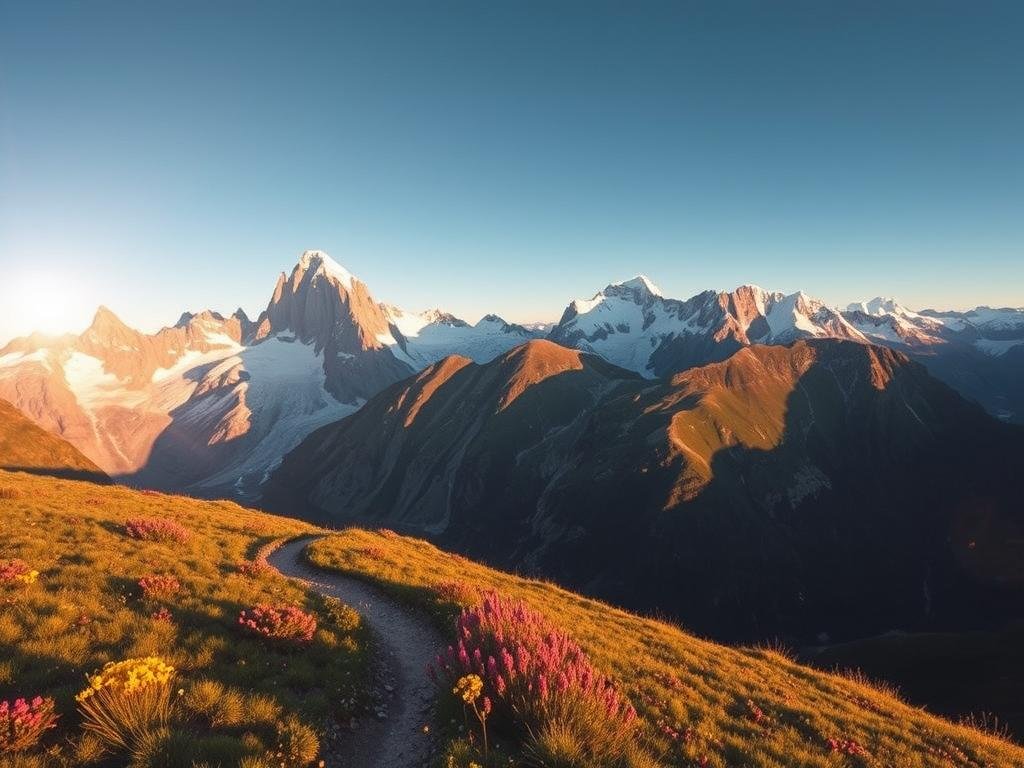
A Legacy of Alpine Adventure
Originally a ski tour, the route was adapted for hikers in the 19th century. It remains one of the world’s most scenic treks, blending French and Swiss cultures. Expect charming villages, glacial valleys, and sightings of ibex or marmots.
| Feature | Walker’s Haute Route | Tour du Mont Blanc |
|---|---|---|
| Distance | 204 km | 170 km |
| Elevation Gain | 14,300 m | 10,000 m |
| Technical Difficulty | High (glacier crossings) | Moderate |
| Crowds | Fewer | Peak-season congestion |
The Haute Route demands stamina—averaging 16 km (10 miles) daily with 1,140 m (3,740 feet) climbs. Yet, the payoff is unmatched: panoramic views of Mont Blanc and the Matterhorn, plus serene trails away from crowds.
Best Time to Hike the Haute Route in the Alps
Alpine conditions shift dramatically between seasons, making timing critical. Mid-July to September offers stable trails, but elevation and microclimates demand careful planning.
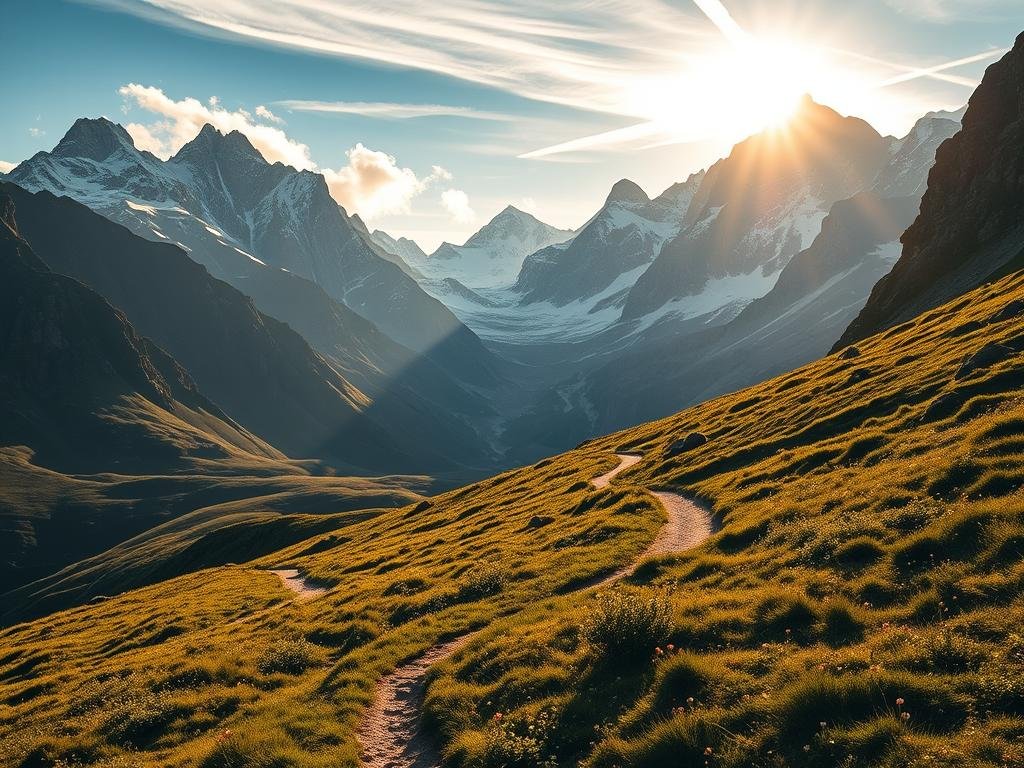
Elevation Dictates Your Experience
Higher passes (2,000–3,000m) hold snow into July, requiring microspikes. Below 2,000m, wildflowers peak in July, while September brings golden larches.
Afternoon thunderstorms are common in summer. Start early to avoid exposure on ridges.
Seasonal Tradeoffs
- July–August: Warm days (up to 24°C) and open huts. Crowds peak in early August.
- September: Cooler (6–18°C) and quieter, but some huts close by mid-month.
Trail crews finish repairs by late June, ensuring bridges are safe. Glacier visibility declines yearly—prioritize earlier treks for iconic views.
Summer Months: June to August
Early summer brings unique challenges for those tackling this iconic route. Snow lingers on 60% of trails until July, requiring microspikes and gaiters for safe passage. High passes like Fenêtre d’Arpette remain technical, with steep snowfields demanding experience.
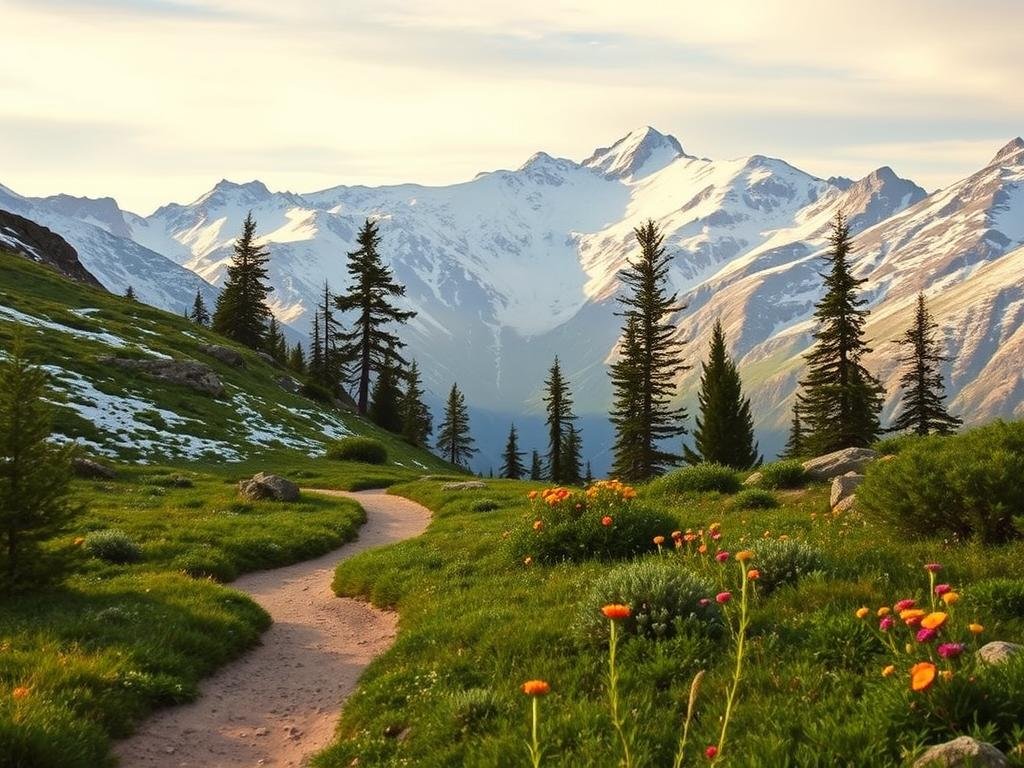
June: Early Season Challenges
Solitude comes at a price. Fewer crowds mean limited transport and hut options—Cabane du Mont Fort opens mid-June. Stream crossings swell with snowmelt, adding risk to long days on the trail.
Yet rewards abound. Photographers capture pristine snowcaps framing the Matterhorn, while gondolas offer less strenuous routes for acclimatization. Early birds also save on costs, with lower hut fees before peak season.
- Gear up: Ice axes may be needed for glacier approaches.
- Plan flexibly: Trail crews finish repairs by late June.
- Check forecasts: Summer snowfalls still occur at elevation.
For seasoned hikers, June balances adventure with alpine trekking’s raw beauty—just pack patience and extra layers.
Autumn Adventure: September and Beyond
September transforms the Alps into a golden paradise, perfect for solitude seekers. With fewer crowds and stable weather, this window offers a unique experience—vibrant larch forests, crisp air, and harvest celebrations in Swiss villages.
Navigating Seasonal Changes
By mid-September, 50% of huts begin closing, requiring advance bookings. Temperatures dip to 5–15°C, demanding thermal layers and a warmer sleeping bag. Pack a water filter, as some streams dry up post-summer.
Val d’Hérens dazzles with golden larches, while early snows dust peaks by late October. Self-guided trekkers should plan meticulously—rescue services scale back, and transport options dwindle.
Essentials for Autumn Trekking
- Gear upgrades: Add microspikes for icy mornings and a windproof jacket.
- Cultural perks: Time your hike with local harvest festivals for a taste of Swiss traditions.
- Flexible routes: Lower-elevation trails remain accessible if passes get snowy.
For those seeking quiet trails and golden landscapes, September is the optimal time—just prepare for shorter days and alpine unpredictability. Explore self-guided tours to tailor your post-season adventure.
Weather Conditions on the Haute Route
Navigating the alpine environment requires understanding its unpredictable nature. Sudden shifts can turn a sunny morning into a hazardous afternoon, especially at higher elevations.
Strategic Timing for Summer Hikes
July brings an average of 12 rainy days, with frequent storms developing after noon. Lightning poses serious risks on exposed cols, making early starts crucial. Many experienced trekkers begin by 5 AM to cross high peaks before clouds gather.
The Rhône and Matter valleys create distinct microclimates. One side might bask in sunshine while the other faces heavy rain. Pack layers and always check regional forecasts.
Essential Safety Measures
- UV protection: Radiation intensifies by 30% at altitude—wear SPF 50+ and sunglasses.
- Emergency shelters: Identify huts along your route in case of sudden weather changes.
- Footwear: Wet trails become slippery—choose waterproof boots with aggressive tread.
Snow patches linger on passes through August, requiring careful navigation. The MeteoSwiss app provides real-time alerts for approaching storms, helping hikers adjust plans.
Trail Accessibility and Snow Levels
High-altitude sections require careful planning due to shifting snow levels. Annual reports from the Swiss Alpine Club show variability—some years, snowfields linger into mid-July, like the Grand Désert glacier. Real-time monitoring via apps like MeteoSwiss helps hikers adjust routes.
Navigating High Passes
The Pas de Chèvres ladder (2,855m) is a critical point, often icy even in summer. Early-season trekkers should opt for the Bovine route instead of Fenêtre d’Arpette, which holds snow longer.
| Route | Best For | Risks |
|---|---|---|
| Bovine | June/September | Exposed to afternoon storms |
| Fenêtre d’Arpette | Mid-July–August | Steep snowfields, crampons needed |
Gear and Safety Tips
- Microspikes: Essential for icy trail sections before August.
- Trekking poles: Stabilize stream crossings swollen by snowmelt.
- SAR access: Note helicopter landing points near Cabane de Prafleuri.
By late September, glaciers become unstable, and passes like Col de Louvie may close. Always check conditions before departure.
Mountain Hut Availability
Securing accommodations along this trek requires strategic planning. The mountain huts (or “cabanes”) are lifelines, offering warm meals and shelter after long days on the trail. Peak season (July–August) sees 90% occupancy, while shoulder months offer flexibility but fewer open options.
Booking Windows and Savings
Popular stops like Cabane de Moiry (2,825m) open reservations in April—book six months ahead for summer dates. Swiss Alpine Club (SAC) members save 20–40% on fees at managed huts, like Cabane du Mont Fort.
| Hut | Peak Season Rate (CHF) | Shoulder Season Availability |
|---|---|---|
| Cabane de Prafleuri | 85 (half-board) | Closed after Sept 15 |
| Europahütte | 75 (dormitory) | Limited Oct–June |
Hut Life Essentials
- Half-board costs: CHF 65–85 covers dinner, breakfast, and dorm space.
- Dorm etiquette: Pack earplugs—snoring is inevitable in shared quarters.
- Winter rooms: Unheated spaces with mattresses for off-season emergencies.
- Warden protocols: Check in by 5 PM or risk losing your spot.
Resupply snacks in villages like Arolla between huts. Some Booking.com listings allow free cancellations—useful for flexible itineraries.
Crowds and Trail Traffic
Trail traffic fluctuates dramatically between seasons on this legendary route. August sees over 300 daily hikers on sections overlapping with the Tour du Mont Blanc. Yet by September, numbers drop by 70%—offering solitude amid golden larches.
Peak Season Strategies
July and August bring the busiest routes, especially near Champex-Lac where paths converge. Smart itineraries avoid popular stops between 11 AM-2 PM when day groups arrive. Consider these alternatives:
- Early starts: Reach cols before 9 AM for crowd-free photography
- Hidden gems: Camp near Zinal or Gruben—quieter than major villages
- Shared transport: Taxis from Le Châble bypass congested trailheads
Trient becomes particularly packed during events like the Tour de France. For a peaceful experience, book accommodations in smaller hamlets like La Sage instead.
Autumn’s Quiet Advantage
September transforms the trail into a personal journey. With most hikers gone, you’ll hear marmots whistling instead of chatter. Mornings offer misty valleys perfect for uninterrupted photography.
Fewer people mean more wildlife sightings—chamois often descend to lower elevations this season. Just verify hut closures if planning late-season treks. For route flexibility, consider self-guided options with adjustable itineraries.
Essential Gear for Seasonal Hiking
Packing the right equipment makes or breaks your alpine adventure. The Haute Route demands versatile gear that adapts to sudden weather shifts and rugged terrain. Whether tackling snowfields or sun-scorched trails, smart choices enhance safety and comfort.
Summer Packing List
Lightweight yet durable items dominate summer treks. The Osprey Atmos 65L pack balances capacity with breathability, ideal for long days on the trail. Pair it with Scarpa Terra GTX boots—waterproof yet flexible for varied sections.
Sun protection is non-negotiable. A UV Buff and Raen Remmy sunglasses shield against intense alpine rays. Light-colored sun shirts with hoods add extra defense without overheating.
Critical Gear Breakdown
- Footwear: Waterproof hiking boots for stability, plus trail shoes for lighter days.
- Water purification: SteriPEN kills pathogens faster than filters in glacial streams.
- Emergency tools: Garmin inReach Mini ensures satellite communication in dead zones.
- Shelter: Thermarest pads and compact tents suit late-season camping.
Don’t overlook socks—three pairs of wool blends prevent blisters during consecutive days of trekking. The Petzl Meteor helmet adds safety in rockfall zones, especially near high passes.
Training and Preparation Tips
Training for multi-day alpine hikes demands both physical and mental resilience. A structured six-month plan prepares you for 1,000m elevation gains and rugged terrain. Focus on building endurance while simulating trail conditions.
Build Strength and Stamina
Start with a 10-lb pack, gradually increasing to 20 lbs to mimic load-bearing days. Train at higher altitudes to understand how your body reacts above 13,000 ft—critical for acclimatization.
Incorporate interval training on steep hills or stairs to boost cardiovascular capacity. Strength workouts should target quads, glutes, and core for stability.
Master Technical Skills
Practice descents on scree and dirt trails to improve balance. *Back-to-back training* simulates consecutive high-effort days, testing your limits.
| Weekly Focus | Activities | Goal |
|---|---|---|
| Mon/Wed/Fri | Cardio + strength | Build endurance |
| Sat/Sun | Weighted climbs (15–20 lbs) | Simulate trail loads |
Fuel and Mindset
Carry water in gallon containers to stay hydrated during 5,000+ calorie trek days. Pack high-energy snacks like nuts and dried fruit for quick fuel.
Mental preparation is just as vital. Visualize challenging sections to build confidence. For adventure-ready essential gear, prioritize lightweight yet durable items.
- Rest days: Incorporate recovery to prevent burnout.
- Flexibility: Stretch post-workout to avoid injuries.
- Consult a physician: Ensure fitness for high-altitude treks.
Conclusion
Glacier retreat adds urgency to experiencing this alpine adventure soon. The world’s iconic landscapes are changing fast—pack Kev Reynolds’ 2023 guide for updated route tips and hut details.
Permits now enforce strict environmental protocols. Carry out waste and respect seasonal closures to protect fragile zones. From Zermatt, trains connect to major hubs like Geneva or Milan.
Support trail preservation by donating to local alpine clubs. Every step counts in safeguarding these routes for future trekkers. For more alpine trekking insights, explore our latest resources.

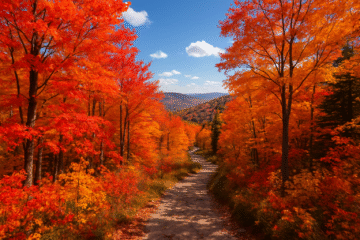
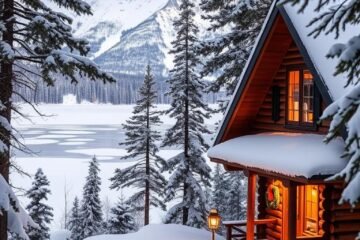
0 Comments